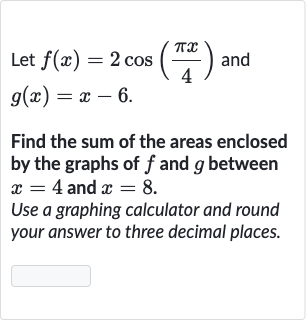Full solution
Q. Let and .Find the sum of the areas enclosed by the graphs of and between and .Use a graphing calculator and round your answer to three decimal places.
- Calculate Total Area: To find the sum of the areas enclosed by the graphs of and between and , we need to calculate the definite integral of the absolute value of the difference between and over the interval . This will give us the total area between the two curves.
- Find Intersection Points: First, we need to find the points of intersection between and to determine if there are any within the interval . This is done by setting equal to and solving for .
- Calculate Area : We will use a graphing calculator to solve the equation , as it cannot be solved algebraically. We are looking for solutions within the interval .
- Calculate Area : After using the graphing calculator, we find that the two functions intersect at . This means we will need to calculate the area between the curves from to and from to separately.
- Sum of Areas: For the interval , is above . We calculate the area by integrating the difference from to .Area =
- Sum of Areas: For the interval , is above . We calculate the area by integrating the difference from to .Area = Using the graphing calculator, we find the value of Area by evaluating the definite integral.Area [integral value from the calculator]
- Sum of Areas: For the interval , is above . We calculate the area by integrating the difference from to .
Using the graphing calculator, we find the value of by evaluating the definite integral.
For the interval , is above . We calculate the area by integrating the difference from to . - Sum of Areas: For the interval , is above . We calculate the area by integrating the difference from to .
Using the graphing calculator, we find the value of by evaluating the definite integral.
For the interval , is above . We calculate the area by integrating the difference from to .
Using the graphing calculator, we find the value of by evaluating the definite integral. - Sum of Areas: For the interval , is above . We calculate the area by integrating the difference from to .
Using the graphing calculator, we find the value of by evaluating the definite integral.
For the interval , is above . We calculate the area by integrating the difference from to .
Using the graphing calculator, we find the value of by evaluating the definite integral.
The sum of the areas enclosed by the graphs of and between and is the sum of and . - Sum of Areas: For the interval , is above . We calculate the area by integrating the difference from to .
Using the graphing calculator, we find the value of Area by evaluating the definite integral.
For the interval , is above . We calculate the area by integrating the difference from to .
Using the graphing calculator, we find the value of Area by evaluating the definite integral.
The sum of the areas enclosed by the graphs of and between and is the sum of Area and Area.
We add the values obtained from the graphing calculator for Area and Area to get the Total Area. - Sum of Areas: For the interval , is above . We calculate the area by integrating the difference from to .
Using the graphing calculator, we find the value of Area by evaluating the definite integral.
For the interval , is above . We calculate the area by integrating the difference from to .
Using the graphing calculator, we find the value of Area by evaluating the definite integral.
The sum of the areas enclosed by the graphs of and between and is the sum of Area and Area.
We add the values obtained from the graphing calculator for Area and Area to get the Total Area.
After rounding the Total Area to three decimal places, we get the final answer.
More problems from Find the magnitude of a three-dimensional vector
QuestionGet tutor help
QuestionGet tutor help
QuestionGet tutor help
QuestionGet tutor help
QuestionGet tutor help
QuestionGet tutor help

